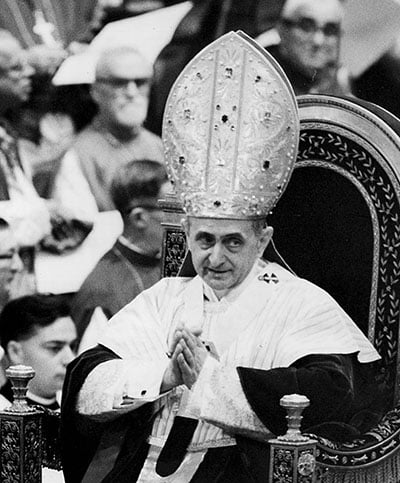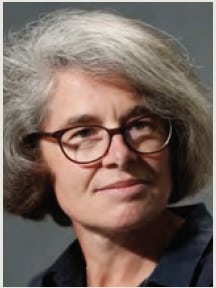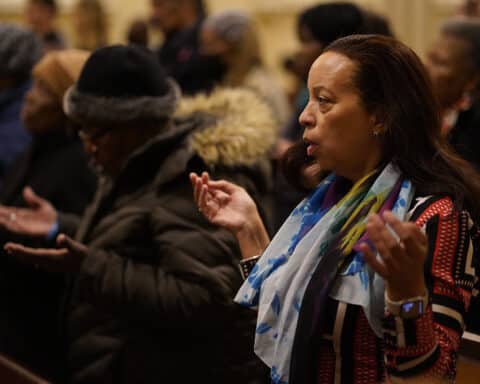“Synodality is a style, it is a walk together, and it is what the Lord expects from the Church of the third millennium.” Pope Francis said that in November 2019 to a meeting of the International Theological Commission, a prestigious Vatican advisory body that a year earlier had published a study entitled “Synodality in the Life and Mission of the Church.”
In the months and years since the pope spoke, synods and synodality have been much in the news thanks partly to a controversial “Synodal Path” experiment taking place in Germany. And in October 2022, a general assembly of the international Synod of Bishops will convene in Rome for its own discussion of the theme — chosen by Francis — “For a synodal Church: Communion, participation and mission.”
All of which suggests two obvious questions: What is a synod, and what does synodality mean?
Synodal roots
The word “synod” is a combination of two Greek words — sun (meaning “with”) and odos (meaning “path”). Thus synod and synodality signify walking together with others or, more broadly, a journey by companions marked by fellowship and sharing. In ecclesial terms, this corresponds to the image of the Church as a pilgrim people traveling through the centuries on the way to the final fulfillment of all things in Christ.

The International Theological Commission in its document points to a kind of prototype synod in the so-called Council of Jerusalem as it is described in Chapter 15 of the Acts of the Apostles.
In those very early days of the Church, a controversy arose in the city of Antioch over whether non-Jewish converts had to be circumcised, as Jewish law prescribed. The local Christians decided to send Paul and Barnabas to Jerusalem to consult the “Apostles and elders” of the mother Church on what should be done. In Jerusalem an “assembly” was convened, and after discussion and debate, a decision was reached: no circumcision would be required, but idolatry and “unchastity” would not be tolerated, and some dietary laws would still have to be observed.
Calling this a “paradigm” for synods, the International Theological Commission states that sharing views and heeding the Holy Spirit on this occasion brought it about that “initially divergent opinions move toward the consensus and unanimity that are the fruit of communal discernment.” The commission calls this “a real-life demonstration that the way the People of God moves forward is something orderly and well thought out, where each person has a specific position and role” (“Synodality in the Life and Mission of the Church,” No. 21, 22).
| The Council of Jerusalem |
|---|
 The International Theological Commission cites the Christian assembly often called the Council of Jerusalem as an early example of the synodal approach. The principal account of this event, taking place around the year A.D. 49, is in Chapter 15 of the Acts of the Apostles. A dispute had arisen in the city of Antioch, where non-Jews had lately been joining the Church. Some people argued that these converts should be circumcised and required to observe the rest of the Mosaic law. Others, and principally St. Paul, said no. So Paul and several companions were chosen to go to Jerusalem and place the matter before “the apostles and the elders” gathered there. At a key point in the deliberative process, Peter, the head of the apostles, pronounced judgment in support of Paul’s position. Then Paul and his companion Barnabas spoke. And finally James, leader of the Jerusalem community, gave instructions to write the Gentile converts in Antioch telling them they needn’t be circumcised but should avoid idolatry and sexual license, and observe some dietary restrictions. Underlining the synodality of this key episode in the early Church, the theological commission remarks that during these deliberations as described in Acts, “everyone plays an active part, though with varied roles and contributions” (“Synodality in the Life and Mission of the Church,” No. 21). |
Evolution of the synod
Over the centuries since then, synods of various kinds have often been held. Today, many Christian churches and religious groups have bodies they designate as synods as part of their structure. In the Catholic Church, the Code of Canon Law for the Western Church covers synods of two kinds — the international Synod of Bishops, mentioned above, and diocesan synods.
The code devotes nine canons to diocesan synods, specifying their purposes, members and operations. Canon 460 gives this very general statement of what a diocesan synod is — “a group of selected priests and other Christian faithful … who offer assistance to the diocesan bishop for the good of the entire diocesan community” — while Canon 466 emphasizes that the bishop is a diocesan synod’s “sole legislator” while the other members have “only a consultative vote.”
At least eight U.S. archdioceses and dioceses have either held synods in the last decade or announced plans to do so.
The latest is Dallas, where Bishop Edward Burns in February announced plans for a diocesan synod composed of clergy, religious and laypeople to begin next year and continue for 10 years. He said it would focus on developing a pastoral plan for the rapidly growing diocese.
“Recommendations and suggestions of the faithful will be given to the synod body, who will consult and vote on resolutions to be presented to the diocesan bishop,” he said.

Diocesan synods have existed in the Church for a long time, but the international Synod of Bishops is, comparatively speaking, something new — an innovation proposed by the Second Vatican Council (1962-65) in its decree on bishops, Christus Dominus. What the council had in mind was a body “acting in the name of the entire Catholic episcopate” by means of which the world’s bishops would join the pope in the governance of the whole Church — in the words of Vatican II: to “show that all the bishops in hierarchical communion partake of the solicitude for the universal Church” (Christus Dominus, No. 4).
Pope St. Paul VI announced the creation of this new entity at the start of the council’s fourth and final session in 1965. Expectations were high at the start. Father Joseph Ratzinger, then a young German theologian who had played an active role in the ecumenical council and later was known to the world as Pope Benedict XVI, wrote at the time that the synod would be “a permanent Council in miniature.” But the reality has turned out to be something less.
To date, there have been 15 “ordinary” assemblies of the synod — next year’s will be the 16th — as well as three “extraordinary” assemblies and several “special” assemblies, including sessions for Africa and the Amazon region. Subjects covered have included, among others, evangelization, religious education, priestly formation, consecrated life and the laity.
Complications of synods

The Synod of Bishops has established itself as a permanent part of the Church’s life and has been the starting point for several excellent papal documents. But sometimes, too, it has been a source of frustration. Reflecting on his experience as an elected U.S. delegate to the assemblies of 2015 and 2018 — which were on the family and young people, respectively — Archbishop Charles Chaput, former archbishop of Philadelphia, complained of “manipulation” by elements “within and outside the Church.”
“Synods should be places where people speak freely and are anxious to listen to others. But both [assemblies] were exercises of power rather than efforts to arrive honestly at a common position through listening and the inspiration of the Holy Spirit,” he writes in his new book, “Things Worth Dying For” (Henry Holt and Co., $25.99).
As that suggests, not everything flying the flag of synodality is necessarily a good idea. A case in point is Germany’s Synodal Path.
The project, a joint undertaking of the German bishops’ conference and a lay group called the Central Committee of German Catholics, raised concerns from its beginning two years ago by saying it would make “binding” changes. Vatican criticism has focused on the fact that the German body cannot change universal Church doctrines and laws. “No one has given that authority to the German synod,” the secretary of the Vatican’s Council for Legislative Texts, Bishop Juan Ignacio Arrieta Ochoa, said in a Catholic News Agency interview.
| Role of the Laity |
|---|
 Synods and synodality are often described as reflections of the vision of the Church as a community as found in the teaching of Vatican Council II. Here is a key passage in the council’s dogmatic constitution on the Church, Lumen Gentium: “As all the members of the human body, though they are many, for one body, so also are the faithful in Christ. Also, in the building up of Christ’s body there is engaged a diversity of members and functions. There is only one Spirit who, according to his own richness and the needs of the ministries, gives his different gifts for the welfare of the Church” (Lumen Gentium, No. 7). Developing and applying this view of the Church, the Catechism of the Catholic Church says this about the laity: “In the Church, ‘lay members of the Christian faithful can cooperate in the exercise of this power [of governance] in accord with the norm of law.’ And so the Church provides for their presence at particular councils, diocesan synods, pastoral councils, the exercise of the pastoral care of a parish, collaboration in finance committees, and participation in ecclesiastical tribunals, etc.” (CCC 911). |
But the Germans have plowed ahead, and the Synodal Path now is nearing its end. Reasons for critics’ concern are evident in a 38-page text on “power” in the Church that found its way into journalists’ hands. Carrying the names of Bishop Franz-Josef Overbeck of Essen and Dr. Claudia Luecking-Michel, vice president of the central committee, the document argues for making secular liberal democracy as the working model of a Church where synodal bodies make the decisions.

study of the extent of clerical sexual abuse in their country and its possible causes, chose to initiate a “synodal” process that was not a synod or a plenary council. CNS photo/Harald Oppitz, KNA
Affirming the legitimacy of “plurality in questions of truth and doctrine,” the text sketches a vision of a church in which bishops and pastors are elected and term-limited, while the pope’s role in selecting bishops is simply to confirm those chosen by an electoral process. It also takes a predictably friendly view of married priests and women priests.
And despite its call for a democratic church, the document is more authoritarian than permissive in the end. Insisting that “reforms” are necessary, it says: “The ability to act must not be put at risk [by continued debate]. … We expect that recommendations and decisions adopted by the majority will also be supported by those who have voted differently. … We expect everyone to help promote the ability of the synodal assembly to act.”
Predicting where all this will end is impossible just now, but it hardly seems likely Pope Francis will swallow it whole.
| New Voter |
|---|
 Last February Pope Francis appointed a Spanish priest, Father Luis Marin, and a French nun, Sister Nathalie Becquart, as undersecretaries of the Synod of Bishops, whose next general assembly will take place next year in October on the theme “Synodality in the Life and Mission of the Church.” In an interview with Vatican News, Cardinal Mario Grech, general secretary of the Synod, said both undersecretaries would be active in preparing for the next assembly and both would be able to vote there. If Sister Nathalie does in fact cast a vote, it will be the first time a woman has done that in one of these assemblies, although women have previously served as experts and auditors, and Sister Nathalie has been one of four women consultors of the Synod’s general secretariat since 2019. |
What it means for the future
Auxiliary Bishop Robert Barron of Los Angeles, founder of the Word on Fire media evangelization program, attended the Synod of Bishops’ 2018 assembly on youth along with Archbishop Chaput. During that gathering, he was disturbed at finding — inserted into one of its texts without previous discussion — an endorsement of synodality “so imprecise that it gave the impression that the Church is a kind of freewheeling democracy.”
Later, he said, he was further alarmed at learning the Germans’ Synodal Path was open to changing fundamental doctrines and laws.

Thus, Bishop Barron said last year in a commentary posted on his Word on Fire website, he was relieved when the subject of synods and synodality came up during an audience he and bishops of his region had with the pope.
“Francis was clear and explicit. He told us, in no uncertain terms, that a synod is ‘not a parliament,’ and that the synodal process is not simply a matter of canvassing the participants and counting votes. … The point of a democratic assembly is to discern the will of the people, for in a democratic polity they are finally sovereign. But in a synod the point is discerning not the will of the people but the will of the Holy Spirit, for the Spirit in that context is sovereign.”
“Whatever Pope Francis means by ‘synodality,'” Bishop Barron concluded, “he clearly doesn’t mean a process of democratization or putting doctrine up for a vote. He means … a structured conversation among all the relevant ecclesial players — bishops, priests and laity — for the sake of hearing the voice of the Spirit.”
Synodality is something very old in the Church and also, in modern times at least, something very new — a concept whose purposes and institutional embodiments we have only recently begun to explore. False starts and missteps, as in Germany’s Synodal Path, are probably unavoidable. And like warning signs along a road, they point to mistakes and dangers to avoid without calling a halt to the journey. “There is always a danger of schism lying in wait,” the theological commission warns.
But the hope, if not yet the certainty, is that the outcome of synodality will eventually be a stronger, more attractive community of faith marked by participation and dialogue and involving all its members. More than just structures and meetings, synodality as Pope Francis understands it signifies a certain “style” — a way of being a church in which all the members have roles to play. Next year’s general assembly of the Synod of Bishops has an important opportunity — as well as a serious duty — to contribute to bringing that about.
The International Theological Commission puts it like this: “The teaching of Scripture and Tradition show that synodality is an essential dimension of the Church. Through synodality, the Church reveals and configures herself as the pilgrim People of God and as the assembly convoked by the risen Lord. … Synodality is not simply a working procedure, but the particular form in which the Church lives and operates” (“Synodality in the Life and Mission of the Church,” No. 42).
We are just getting started on realizing that vision.
Russell Shaw is a contributing editor for Our Sunday Visitor.






